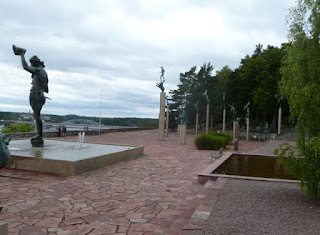The next time you're in Sweden visit Millesgarden, a fabulous home, art environment, terraced sculpture garden, and gallery space overlooking Stockhom Harbor.
It was created by and for sculptor Carl Milles (who studied with Rodin) and his wife, Austrian-born painter Olga Granner Milles, in the artistically simmering early decades of the last century.
This object to the left is a actually a (very thin) sponge, purchased in the gift shop, but I won't be mopping up spilled champagne with it anytime soon. I love the way its Wiener Werkstatte-inspired design and colors look on my aqua-green kitchen wall!
The graphic in the upper corner of the sponge replicates the design of this wrought-iron gate on the grounds. My Swedish is too rusty (okay; nonexistent) to translate the words, but I can read the date well enough: 1920.
This was right around the time the intricate, floral Art Nouveau aesthetic was starting to segue into the clean, machine-made design motifs of Art Deco.
Milles' bronze sculptures are monumental, mostly figures taken from Greek, Roman, and Christian mythology. On the grounds of Millesgarden, they are made even more imposing by their gravity-defying placement on tall, thin pedestals.
(For scale, see the tiny figures huddled at the low wall to the left, between the huge statue in the foreground, and the little spritz of water bubbling out of the fountain to its right? Those are actual people; that's how gigantic these sculptures are!)
 |
| Carl Milles' sculpture garden: monumental. |
Austrian-born architect and textile designer, Josef Frank, who relocated to Sweden in the second half of his life, had a hand in some of the building on the Millesgarden grounds.
When we were there, the Millesgarden gallery was hosting an exhibition of Frank textiles, created by the Swedish design group, Svenskt Tenn, with which Frank had a long association.
These are modern textiles based on Frank designs, shown alongside Franks' original watercolor sketches of each pattern. The colors are bold, the attitude playful, and the images abstract and amorphous, or wonderfully curvy, inspired by the fecund shapes of flowers, fruits, and leaves in nature.
 |
| Josef Frank: "Terrazzo." |
Wall tapestries of Frank's designs were hung amid pieces of furniture upholstered in these same patterns, ebulliently padded and poofy sofas, pillows, and chairs.
(Frank's dislike of hard, sharp corners is thought to have inspired Apple designer Jonathan Ive, a Frank fan, in his creation of the original blue iMac.)
I loved the designs for "Terrazzo," inspired by Italian mosaics. I also liked the starry, cloudlike silhouettes of "Zodiac," and a design based on images of historical sailing ships.
But for me, Best in Show was this whimsical riff on the classic bearskin rug (displayed only a couple of inches off the floor). The best thing about this life-sized accent piece is that it doesn't require the death of an actual animal to produce!
Oh, and the title of this piece? "Beast."



No comments:
Post a Comment